Chances are, as a teacher, you'll hear the word ‘grant’ quite a bit among friends, peers, and administrators. Chances are, you may have even applied for some, too. These days, it’s really not uncommon for teachers to spend their free time perfecting grant applications and chasing many opportunities. The problem is that many others are doing that too and there are only so many awards to go around. That's why we also offer an EdTech grant program and award two $500 STEM grants to deserving educators each month. We’re very excited to continue to provide this opportunity and to help shrink the size of the applicant field when compared to many other grant opportunities. So, this week, we're covering some top reasons for STEAM teachers, tech specialists, and anyone else to apply.
What You Can Get
If you’ve never browsed our online store, we highly suggest that you do. Not only will you find hundreds of useful EdTech items, but just about all of these STEAM tools are available for purchase using grant dollars. Even if you received different grants, we’re happy to help educators purchase educational technology with that grant cash. Anyway, our store features six main categories: Makerspace, Robotics & Coding, Esports, 3D Printing, Virtual Reality, and Drones. You guessed it—any item from any of these categories is available for your grant funds. Grant recipients could even pick and choose from all the different categories, creating a cart of customized classroom technology that fits within the $500 range, which ensures you’ll get exactly what you need for your students.
Some of our awardees take full advantage of that variety on our store and request EdTech from all different categories. Another commonality is educators asking for a bunch of different inexpensive STEAM tools and creating a bundle of up to 20 different items also from a variety of store categories. Some of the technology on our store is quite affordable, giving all our grant recipients more freedom if they happen to be looking for low-tech supplies to add to or start a makerspace or just complement what they already have. Of course, if teachers want to put it all towards one slightly more expensive item, we can accommodate that, too. Many of our best robotics, coding, and maker offerings fall within the $100-$200 range, meaning grant awardees could request two or three of them and then sprinkle in a couple less expensive items—it's truly up to you.
We are always adding new technology to our store, expanding the opportunities for all our grant recipients. Within the larger categories, there is truly something for everybody, including robotics tools for Pre-K and kindergarten students, elementary kids, middle schoolers, or high school students. The same goes for the circuitry, coding, and VR categories, also. Many of the 3D printers and drones are more for older students, but there are options for all children. If you are unsure if a particular technology will mesh well with student ages and ability levels, let us know. We are happy to offer advice and guidance to help ensure you receive something that’s genuinely helpful. Ultimately, we recommend looking around our store before submitting your application to ensure you find something that you can use and something new that will excite you.
Our Selection Criteria
When we launched our EdTech grant program, we did so with more in mind than giving away some lesser-known tech tools or hoping that educators we selected would promote our company. We wanted to make sure we were truly helping those educators who demonstrate both elements of passion and financial need. It’s unfortunate, but the truth is that many teachers can't always give every kid a true 21st century learning experience. And, more often than not, that comes down to money. Educators usually know what tools give kids opportunities that'll shape their futures, but are sometimes handcuffed by administrative requirements. With that said, we'll absolutely take into account the need for assistance that these educators demonstrate along with their commitment to using their potential award in the classroom to benefit their students.
Our grant recipients include all different types of educators, like those working to improve innovative STEM programs for kids, those who demonstrate a financial need, and those who have a clear plan for leveraging new technology effectively. Besides that, we also look for educators who can add this technology into their programs swiftly—preferably within six months. This helps to ensure that their technology remains viable if teachers don't implement it right away and also helps guarantee kids get to use something that’s new and cutting-edge. Besides all that, we want to help teachers discover new EdTech solutions because we know they don’t always have the time to do this research on their own. Once we establish a relationship, we can collaborate to help enhance these plans or perhaps suggest something slightly different to help them truly make the most of their grant dollars.
Though not always a consideration, we'll definitely notice mentions of truly unique projects the applicant is planning. In fact, one of our favorite ever applications was from a teacher who was searching for additional STEM tools to help some students build a district STEAM bus that they were planning to take from school to school to give students opportunities to take part in extra STEAM learning. Anything that helps teachers establish a true 21st century environment is something that we'd love to help you develop. Also, our other ultimate goal is alleviating some financial burdens while also giving students a chance to develop relevant skills. If you feel like you exemplify these qualifications, we encourage you to apply for next month’s grant awards and any others in the future that you would like.

Eligibility is Easy
There are some EdTech grant opportunities that only certain educators are eligible to apply for. And, there are others with real specific attributes applicants need simply in order to apply. Not for ours, however. Any educator can apply for our educational technology grant, even doing so multiple times until they receive it. We also know that innovation is not limited to the classroom during the school day. Many school librarians and makerspace leaders are trying to find new ways to add exciting technology to learning as well. That is why we want to continue spreading the word about out grant program. These eligibility rules are incredibly straightforward because, well, everyone is eligible, including classroom teachers, administrators, librarians, makerspace leaders, and anybody else who works in the school community.
We’ve also truly embraced the variety of roles of the recipients we’ve selected, too. We’ve had elementary teachers, public librarians, STEM teachers, nonprofit managers, and makerspace leaders receive the grant awards before. If you haven’t heard all of these stories, you can read the various blogs. The very first grant we awarded went to adding some STEAM tools to a local school makerspace. They were converting an old locker room into that makerspace, which we thought was a genius idea, and we were all happy to make an impact locally and also help them enhance that transition. And, as mentioned, another recipient was in the process of refurbishing an old school bus as a mobile STEAM machine. She wanted to help make STEAM experiences accessible to all children, especially those with economic and intellectual disadvantages. So, they now host community STEM nights, giving kids the opportunity to try just that.
This just goes to show the scope of applicants we’ve received over the years—something that we’re proud of. Although we can’t award something to everyone, we definitely notice those with plans for incorporating technology in very creative ways. And, along those lines, there's always one story that comes to mind. An employee for the American School for the Deaf, this grant recipient used the Root Robot, KEVA kits, and MakeDo kits with her students to expand on her basement makerspace and provide them with fun, visual learning experiences. Her goal was to empower students to work more with their hands—something that most of the EdTech solutions on our store would allow. So, no matter what you teach or how specialized your role is, anyone can apply for our monthly grants. We love helping educators innovate and providing some well-deserved technology tools is a great bonus.
So Many Options
Part of the appeal of our EdTech grant versus others is all the STEM and EdTech options we provide. Our store features hundreds of top-tier STEM, CTE, and MakerEd learning tools from some of the world’s best providers. We search globally for great EdTech solutions from reputable manufacturers and work with them to get them on our store. Plus, the price these grant recipients “pay” is the Educator Discount price that we offer, not the MSRP. The most extensive category on our store, with hundreds of options to choose from, is the robotics section. Here, educators (and grant recipients) can find hundreds of educational robotics tools and bundles from amazing brands, including Ozobot, Wonder Workshop, Terrapin, Edison, and plenty of others. Whether it's beginner level robotics, advanced coding, or sets kids can build, you’ll find something within the $500 award amount.
If you’ve explored our site, you may have seen the store categories on top. Any of the STEM tools in those sections are available for purchase with funds from our grant program. In addition to the robotics category, others include coding, drones, virtual reality, esports, 3D printing, circuitry, maker tools, and more. Even if your items exceed the $500 award amount, recipients could put $500 towards them and pay the difference with another method (like a purchase order). Once again, you’ll find some popular and well-trusted brands within these categories—whatever STEAM focus you decide on taking. Our circuitry category is highlighted by the micro:bit and Monk Makes kits, which help kids learn about circuitry, engineering, problem solving, and even coding. We also offer popular products from Makey Makey, Thames & Kosmos, Snap Circuits, and more in the circuitry section alone.
Other EdTech items that are super popular for education include programmable drones and virtual reality systems. We offer each of those as well, including some lower-end drone models that'll fit within this $500 award amount. Our flagship VR offering is the RobotLAB Expeditions 2.0 product line, and the various kits to choose from—although they're currently each above that $500 threshold. For drones, our top options in the Tello EDU and CoDrone EDU are each under $500 while the other drone kits are more costly. The point is that there are always new, cutting-edge technologies in the education world and we try to help teachers acquire them at as low of a cost as possible. That is why we created an alternate avenue for doing so with our grant program. Hopefully, if you apply, there's something in these categories that you can put to good use in your classroom.

Improve Your STEM Library
Whether you’re currently starting out with STEAM lessons or already a seasoned veteran, there’s always something new you can try. It’s also possible that there are other STEM tools out there that pair perfectly with the ones you already have. Electric Paint, for example, works with the Makey Makey, and we know educators often use this STEAM tool in instruction. Adding the artistic element of the conductive Electric Paint can help you turn STEM to STEAM and give children more opportunities to be creative. Or, maybe you’ve been focusing on robotics in your STEM teaching and want to add new elements to the equation. There are various classroom robots children could build themselves, giving them the chance to combine robotics and coding with engineering. Whatever instructors hope to accomplish, we can provide various forms of technology to help make that possible.
The beauty of our grant program is that it gives teachers the chance to try something new. We know that a lot of educators create year-long or semester-long projects and challenges for students, so this could even help them move away from that and try some coding for a couple of hours each week. Or, perhaps children are planting and taking care of classroom plants and you want to create a more interactive experience. The Experimental Greenhouse Kit from Thames & Kosmos can help keep them excited about these plants while they learn new things about them. Basically, whatever you’re covering in your classroom can likely connect to a hands-on set of STEM tools. Having some willingness to try some new things is great and applying for our grants can help get you started.
In many schools, educators from different grades and subject areas share their STEAM tools. This could be one approach to applying for grants—collaborating on the application and sharing tech tools between their classes. Also, teachers could combine their classrooms and create a highly collaborative environment with various learning outcomes. This works super with students a couple of grades apart (second and fifth, for example). Your older students tend to take the younger ones under their wing and show them new things. Plus, you’ll realize how your hard work and dedication contribute to children using new technology in the classroom. If you’ve received one our grants over the years, we congratulate you and hope those STEM tools remain impactful. If you’ve applied and haven't been selected, we'd encourage you to keep trying. And, if you haven’t applied (or want to apply again), you can find the application here.
For the latest EdTech, STEM, and 21st century education news, follow us on Twitter and Instagram. Like us on Facebook, too, or sign up for our newsletter for our latest product announcements and offerings. If you have an idea for an Eduporium Weekly theme, send us a message on social media or comment below.



